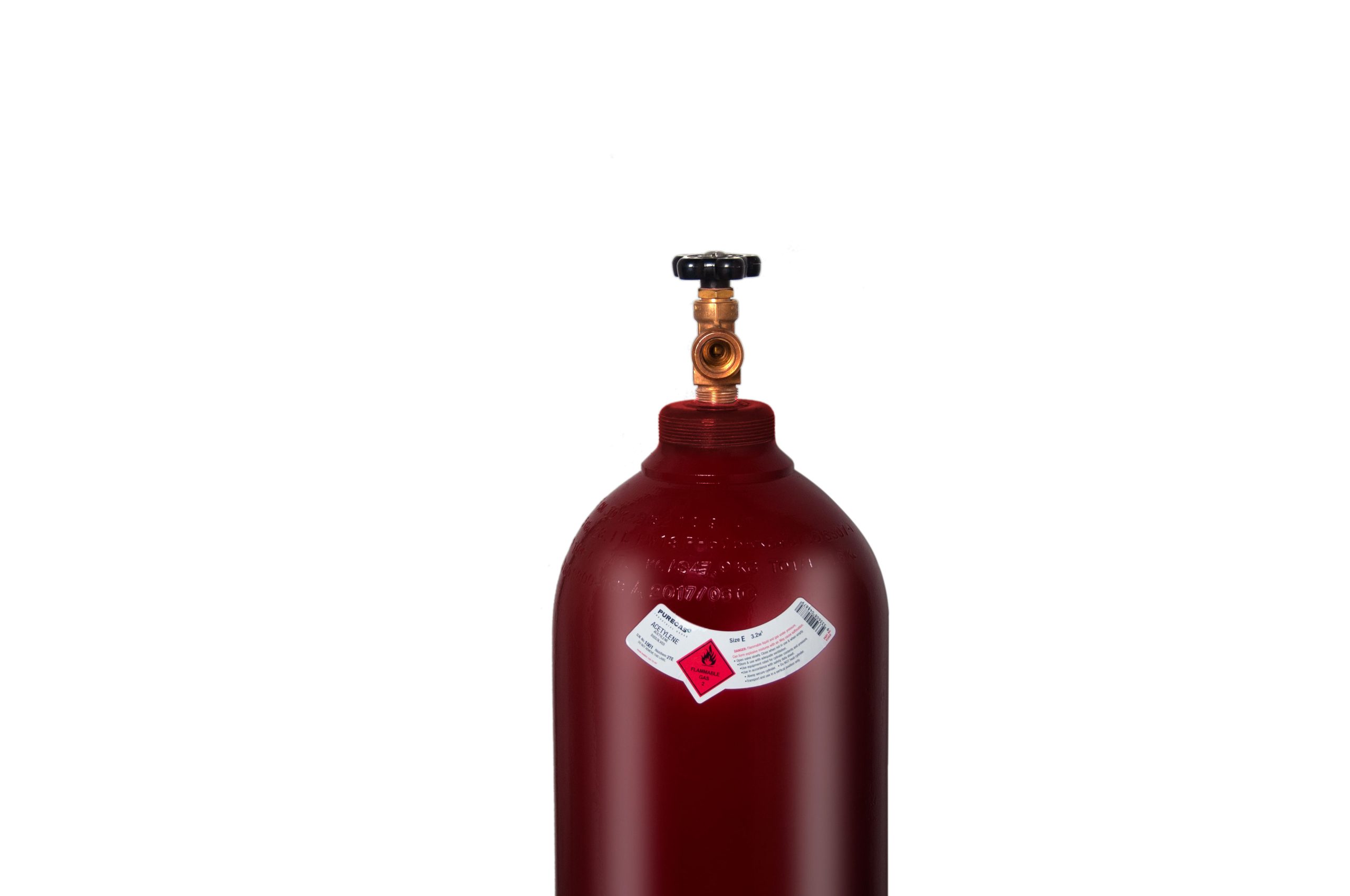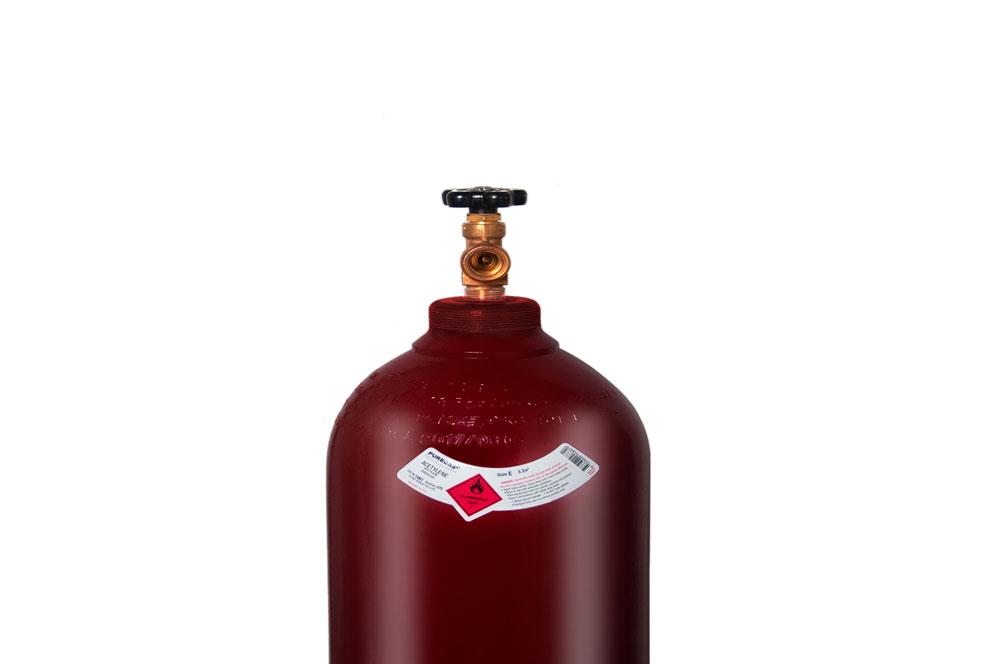

Acetylene is a highly flammable colourless gas with a characteristic garlic like odour.
In high concentration it is an asphyxiant.
Density @ 15 °C and 101.33 kPa: 1.068 kg/m3 (0.89 relative to air)
Applications
- Oxy-acetylene welding
- Oxy-acetylene cutting
- Flame heat treatment
- Chemical industry applications
- Fabrication
Product Overview
Acetylene is a highly flammable colourless gas with a characteristic garlic like odour.
In high concentration it is an asphyxiant.
Density @ 15 °C and 101.33 kPa: 1.068 kg/m3 (0.89 relative to air)
Applications
- Oxy-acetylene welding
- Oxy-acetylene cutting
- Flame heat treatment
- Chemical industry applications
- Fabrication
Hazards
Acetylene is most commonly used with Industrial Oxygen and jointly referred to as “Oxy acetylene”.
Oxy acetylene is a highly flammable combination and therefore utmost care should be taken while handling these two gases.
Exposure to high concentrations can cause suffocation in adition to the extremely high risk of an explosion an/or fire.
The interior of acetelyene cylinders are all filled with a lightweight porous mass (Often referred to as a “Filler”.) which acts like a sponge which is filled/saturated with acetone.
The Acetylene is dissolved in the acetone solvent and as both the acetylene gas & acetone are flammable, these cylinders need to be stored & used in an area with low fire risk & away from heat & ignition sources.
i.e. absolutely NO SMOKING near or in the vicinity of these products & before using this gas the notes & hazards on the label need to be read & understood together with training relating to the use & storage of this extremely flammable gas.
Cylinder Sizes
|
Specifications |
C |
D |
E |
G |
|
Contents weight (m3) |
0.3 |
1 |
3.2 |
7 |
|
Cylinder water capacity (L) |
3 |
10 |
23 |
50 |
|
Cylinder pressure (101.325kPa @15°C) ** |
15500 |
15500 |
15500 |
15500 |
|
Cylinder colour |
Maroon |
|
||
|
Cylinder connection type |
Type 20 |
|
||
The volume and the pressure of the contained gas in the cylinders will be as specified in the above table.
**Cylinder contents pressure is referenced at 15 Deg Celsius. Hence, the pressure in the cylinders can vary depending upon the ambient temperature.
Important Info
STORAGE HANDLING & LEAKS
- Store, handle & transport in an upright position per the illustration below.
- Cylinders should be segregated by hazard classifications when in storage. e.g. Flammable gasses cylinder should not be kept in the vicinity in accordance with the Puregas & AS (Australian Standards.) safety guidelines.
- When using Acetylene (Invariably Oxy Acetylene.), fire extinguishing equipment should be readily available.
- Make sure the cylinder when used is matched with the correct regulator and end connectors and of appropriate pressure rating.
- Inspect the regulator and cylinder valve connections to make sure that they are not contaminated with grease, oil, dirt, water or solvents. Never use grease or oil to lubricate regulators or cylinder valves as this will contaminate the gas.
- Open (Anti clockwise looking down at the hand wheel, directional arrows are on the hand wheel.) or close a cylinder valve (Clockwise looking down at the hand wheel, directional arrows are on the hand wheel.) by hand using moderate torque to open or close them. Too much closing torque can damage the cylinder valve seat. Only use set spanners or specific tools that are provided by the cylinder supplier to connect accessories. Multi-grips should never be used. Some regulators require a sealing washer in or on the inlet spigot. Check that this is present before fitting the regulator to the cylinder valve outlet.
- Gas cylinders (particularly E size) can be unstable & must be stored in pallets or racks when not in use & secured when in use by a strap or chain against a wall or secured by a suitable trolley with chain or strap.
- Use appropriate materials for chains. e.g. plastic coated wire cable, commercial straps, with tensioners,… etc., to secure cylinders.
- Gas cylinders should not be stored in public hallways or other unprotected areas
- Store out of direct sunlight and away from sources of heat and ignition; temperatures must not exceed 50 °C.
- Where cylinder caps are fitted to cylinders (i.e. instead of Cylinder Valve guards.) refit these cylinder valve caps to the Cylinder thread when the cylinder is not in use.
- Cylinders should be protected from damage. Do not store cylinders near elevators or gangways, or in locations where heavy-moving objects may strike or fall on them or knock the cylinder over.
- Cylinders must be stored on surfaces such as suitably drained concrete to prevent the base of the cylinder from rusting from standing in puddles for long periods. Cylinders should be stored, secured in premises to protect them from theft & against tampering by unauthorized individuals.
- Storage areas must be well-ventilated, cool, dry, and free from corrosive materials.
Handling Leaks
- The majority of leaks relate to the connected equipment.
- Do not enter an area with high gas leakages without proper PPE or safety equipment.
- Approach the leaking cylinder only if you are trained & have the knowledge & experience to deal with the leak.
- Use readily available techniques like the soap bubble method to pinpoint the leak.
- If closing the Cylinder Valve does not stop the leak, then relocate the cylinder to a safer spot without the presence of ignition sources or electrics in the vicinity. i.e. Per Puregas Safety Guidelines.
- Contact your State Emergency Services if the leak is high & cannot be stopped.
- After all the gas has been safely vented, return the empty cylinder if the leak persists.
- Make sure the cylinder is properly tagged indicating the nature, location & date of the leak together with a contact name & phone number for follow up by the gas supplier.



 Facebook
Facebook Instagram
Instagram